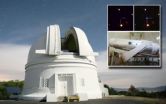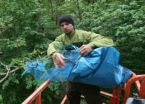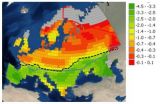(Press-News.org) PASADENA, Calif.-They're bright and blue-and a bit strange. They're a new type of stellar explosion that was recently discovered by a team of astronomers led by the California Institute of Technology (Caltech). Among the most luminous in the cosmos, these new kinds of supernovae could help researchers better understand star formation, distant galaxies, and what the early universe might have been like.
"We're learning about a whole new class of supernovae that wasn't known before," says Robert Quimby, a Caltech postdoctoral scholar and the lead author on a paper to be published in the June 9 issue of the journal Nature. In addition to finding four explosions of this type, the team also discovered that two previously known supernovae, whose identities had baffled astronomers, also belonged to this new class.
Quimby first made headlines in 2007 when-as a graduate student at the University of Texas, Austin-he discovered what was then the brightest supernova ever found: 100 billion times brighter than the sun and 10 times brighter than most other supernovae. Dubbed 2005ap, it was also a little odd. For one thing, its spectrum-the chemical fingerprint that tells astronomers what the supernova is made of, how far away it is, and what happened when it blew up-was unlike any seen before. It also showed no signs of hydrogen, which is commonly found in most supernovae.
At around the same time, astronomers using the Hubble Space Telescope discovered a mysterious supernova called SCP 06F6. This supernova also had an odd spectrum, though there was nothing that indicated this cosmic blast was similar to 2005ap.
Shri Kulkarni, Caltech's John D. and Catherine T. MacArthur Professor of Astronomy and Planetary Science and a coauthor on the paper, recruited Quimby to become a founding member of the Palomar Transient Factory (PTF). The PTF is a project that scans the skies for flashes of light that weren't there before-flashes that signal objects called transients, many of which are supernovae. As part of the PTF, Quimby and his colleagues used the 1.2-meter Samuel Oschin Telescope at Palomar Observatory to discover four new supernovae. After taking spectra with the 10-meter Keck telescopes in Hawaii, the 5.1-meter telescope at Palomar, and the 4.2-meter William Herschel Telescope in the Canary Islands, the astronomers discovered that all four objects had an unusual spectral signature.
Quimby then realized that if you slightly shifted the spectrum of 2005ap-the supernova he had found a couple of years earlier-it looked a lot like these four new objects. The team then plotted all the spectra together. "Boom-it was a perfect match," he recalls.
The astronomers soon determined that shifting the spectrum of SCP 06F6 similarly aligned it with the others. In the end, it turned out that all six supernovae are siblings, and that they all have spectra that are very blue-with the brightest wavelengths shining in the ultraviolet.
According to Quimby, the two mysterious supernovae-2005ap and SCP 06F6-had looked different from one another because 2005ap was 3 billion light-years away while SCP 06F6 was 8 billion light-years away. More distant supernovae have a stronger cosmological redshift, a phenomenon in which the expanding universe stretches the wavelength of the emitted light, shifting supernovae spectra toward the red end.
The four new discoveries, which had features similar to 2005ap and SCP 06F6, were at an intermediate distance, providing the missing link that connected the two previously unexplained supernovae. "That's what was most striking about this-that this was all one unified class," says Mansi Kasliwal, a Caltech graduate student and coauthor on the Nature paper.
Even though astronomers now know these supernovae are related, no one knows much else. "We have a whole new class of objects that can't be explained by any of the models we've seen before," Quimby says. What we do know about them is that they are bright and hot-10,000 to 20,000 degrees Kelvin; that they are expanding rapidly at 10,000 kilometers per second; that they lack hydrogen; and that they take about 50 days to fade away-much longer than most supernovae, whose luminosity is often powered by radioactive decay. So there must be some other mechanism that's making them so bright.
One possible model that would create an explosion with these properties involves a pulsating star about 90 to 130 times the mass of the sun. The pulsations blow off hydrogen-free shells, and when the star exhausts its fuel and explodes as a supernova, the blast heats up those shells to the observed temperatures and luminosities.
A second model requires a star that explodes as a supernova but leaves behind what's called a magnetar, a rapidly spinning dense object with a strong magnetic field. The rotating magnetic field slows the magnetar down as it interacts with the sea of charged particles that fills space, releasing energy. The energy heats the material that was previously blown off during the supernova explosion and can naturally explain the brightness of these events.
The newly discovered supernovae live in dim, small collections of a few billion stars called dwarf galaxies. (Our own Milky Way has 200-400 billion stars.) The supernovae, which are almost a hundred times brighter than their host galaxies, illuminate their environments like distant street lamps lighting up dark roads. They work as a kind of backlight, enabling astronomers to measure the spectrum of the interstellar gas that fills the dwarf galaxies in which the supernovae reside, and revealing each galaxy's composition. Once an observed supernova fades a couple of months later, astronomers can directly study the dwarf galaxy-which would have remained undetected if it weren't for the supernova.
These supernovae could also reveal what ancient stars might have been like, since they most likely originate from stars around a hundred times more massive than the sun-stars that would have been very similar to the first stars in the universe.
"It is really amazing how rich the night sky continues to be," Kulkarni says. "In addition to supernovae, the Palomar Transient Factory is making great advances in stellar astronomy as well."
INFORMATION:
In addition to Quimby, Kasliwal, and Kulkarni, 24 other authors-11 of whom are from Caltech-contributed to the work described in the Nature paper, "A new class of hydrogen-poor super-luminous stellar explosions." This research was supported by the National Science Foundation, the United States-Israel Binational Science Foundations, the Israeli Science Foundation, the Department of Energy, the Gordon & Betty Moore foundation, Gary and Cynthia Bengier, the Richard and Rhoda Goldman Fund, and the Royal Society. The Palomar Transient Factory is a collaboration between Caltech, Columbia University, Las Cumbres Observatory Global Telescope, Lawrence Berkeley Laboratory, UC Berkeley, University of Oxford, and the Weizmann Institute of Science (Israel).
Written by Marcus Woo.
Caltech-led astronomers find a new class of stellar explosions
2011-06-09
ELSE PRESS RELEASES FROM THIS DATE:
Einstein scientists find crucial molecule involved in spread of breast cancer
2011-06-09
June 8, 2011 — (Bronx, NY) — Researchers at Albert Einstein College of Medicine of Yeshiva University have identified a key player in the spread of breast cancer. The findings, published today in the online edition of Nature, identify a critical molecule that helps cancer spread beyond the primary tumor. The research highlights a potential new strategy against metastatic disease. The study's senior author is Jeffrey Pollard, Ph.D., professor of developmental and molecular biology and of obstetrics & gynecology and women's health at Einstein. He also holds the Louis Goldstein ...
New data adds to the hunt for dark matter in the universe
2011-06-09
This week it was announced that a dark matter detector about 700 meters below the ground in a Minnesota mine has recorded a seasonal modulation in staggeringly faint electrical pulses. One possible reason: this could be the result of dark matter particles called WIMPs that envelope the Milky Way galaxy and collide with atoms in the detector's germanium crystal.
This seems possible because the results are consistent with modulation in signals first recorded more than a decade ago by the DArk MAtter/Large sodium Iodide Bulk for RAre processes (DAMA/LIBRA) experiment at ...
The same type of forest is good for both birds and people
2011-06-09
Birds and people both enjoy urban woodlands that have been cleared to just the right degree. This is the conclusion of scientists at the University of Gothenburg who have carried out large-scale field experiments in urban woodlands in south-western Sweden.
"Three out of four people want a mixture of open and untouched forest for rambling. At the same time, we can see that birds do well and continue to nest in woodlands where less than 50% has been cleared", says Erik Heyman of the Department of Plant and Environmental Sciences at the University of Gothenburg.
The natural ...
Turnberry Tower Condominium Enclave Set To Break Its Own Sales Records For 2011 in Washington DC Area
2011-06-09
Named "The Height of Luxury" by The Washington Post, Turnberry Tower was the Washington, DC-area's top-selling luxury condominium project in 2010. The ultra-luxury residential tower is breaking records again in 2011, with $70 million in new sales to date this year -- at an average price of over $1.3 million. This places Turnberry Vice President of Sales and Marketing, Dan Riordan, with a spectacular view of Turnberry Tower's future as the area's tallest residential condominium project. The 26-story, sapphire-blue spire is a beacon adjacent to the Key Bridge, offering ...
Swine flu spread was much wider than first thought, scientists say
2011-06-09
The swine flu outbreak of winter 2009-2010 was much more widespread than was previously realised, research suggests.
Blood samples taken from Scottish adults in March last year at the end of the H1N1 flu season showed that almost half were carrying antibodies to the virus.
Most of the 44 per cent who tested positive had contracted swine flu, although some had acquired immunity from a previous bout of flu, or had been vaccinated.
The research, led by the University of Edinburgh, shows that many cases of swine flu went unreported. Only 100,000 people consulted their ...
MyCare -- the 'card' that could save your life
2011-06-09
It looks like a credit card…it slips into a wallet or purse…but it could mean the difference between life and death in a medical emergency.
The MyCare Card stores personal medical data (e.g. information on existing medical conditions, allergies and medication being taken) and plugs into a laptop's USB port, enabling the data to be accessed in just a few moments.
It is the first device of its type to have been trialled in the UK.
This working prototype has been developed by City University London and Coventry University, with funding from the Engineering and Physical ...
Glaciations may have larger influence on biodiversity tan current climate
2011-06-09
The study, published yesterday in the journal Ecology Letters, analyzed the species richness and the structure of their communities throughout the different regions of the European territory from the Ural Mountains to the Iberian Peninsula. The selection of this family of insects was motivated by their high dispersal ability and because their food sources (mainly cattle and sheep dung) are present throughout the continent.
Research by the Spanish National Research Council reveals that the large impacts occurred during the last ice age maintain their
effects on the current ...
Scale helps to measure the utility of genetic counseling in tackling fear of cancer
2011-06-09
When a person has a family history of cancer, their worry about developing the disease may lead to them refusing to have preventive tests. Advice from genetic counselling units reduces their anxiety but, until now, nobody knew how much. Now, a scientific team has validated the 'Escala de Preocupación por el Cáncer - EPC' (equivalent of the Cancer Worry Scale), the first of its kind in the Spanish language, in order to evaluate it.
"Excessive concern about cancer can result in two kinds of behaviour. Some people undergo excessive and unnecessary diagnostic tests, while ...
German National Academy of Sciences Leopoldina submits statement on energy research
2011-06-09
The German National Academy of Sciences Leopoldina has submitted an ad-hoc statement on energy research to Prof. Annette Schavan, the German Federal Minister of Education and Research. Against the backdrop of the events in Fukushima, the statement contains twelve key declarations that mainly address research-policy issues connected to the restructuring of Germany's energy system.
The German National Academy of Sciences Leopoldina compiled the statement, entitled "Energiepolitische und forschungspolitische Empfehlungen nach den Ereignissen in Fukushima" (Energy- and research-policy ...
Treating children's eye infections without surgery
2011-06-09
PROVIDENCE, R.I. – Researchers from Hasbro Children's Hospital in Providence, R.I., report that medical management may be preferred over surgery for children with orbital cellulitis, an acute infection of the tissues surrounding the eye. They have determined the criteria for surgical intervention should be dependent upon the size of a subperiosteal abscess (SPA). The research is published in the journal Ophthalmic Plastic & Reconstructive Surgery and is now available online in advance of print.
Orbital cellulitis is most often the result of bacteria from a sinus infection, ...





